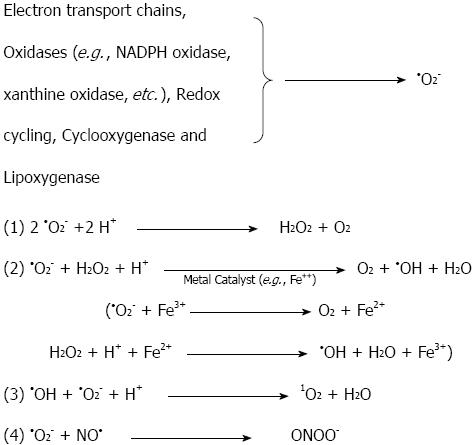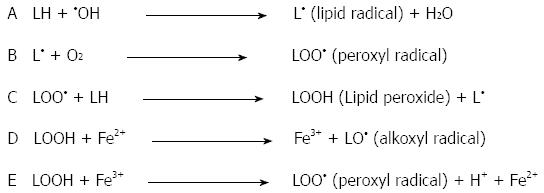Copyright
©2013 Baishideng Publishing Group Co.
World J Gastroenterol. Oct 21, 2013; 19(39): 6540-6547
Published online Oct 21, 2013. doi: 10.3748/wjg.v19.i39.6540
Published online Oct 21, 2013. doi: 10.3748/wjg.v19.i39.6540
Figure 1 Reactions of superoxide (•O2-) that generate highly reactive oxygen species.
•O2- can be dismutated into H2O2, which, in the presence of Fe2+, can generate the highly reactive hydroxyl radical, HO•. •O2- may react with NO• to form the strong pro-oxidant peroxynitrite (ONOO-); alternatively, it may react with HO• to form singlet oxygen (1O2); NADPH: Nicotinamide adenine dinucleotide phosphate.
Figure 2 Initiation and propagation of the free-radical chain reaction of lipid peroxidation.
Reactions D and E represent the metal-catalyzed Fenton reaction.
Figure 3 Two proposed mechanisms through which linoleic acid could increase the production of interleukin-8 via the activation of arachidonic acid pathways.
By the generation of reactive oxygen species (ROS) from the cyclooxygenase and lipoxygenase enzymes to activate Nuclear factor-κB (NF-κB), increasing interleukin (IL)-8 production; or by the use of AA metabolites to increase IL-8 production. LTs: Leukotrienes; Tx: Thromboxane.
- Citation: Alzoghaibi MA. Concepts of oxidative stress and antioxidant defense in Crohn’s disease. World J Gastroenterol 2013; 19(39): 6540-6547
- URL: https://www.wjgnet.com/1007-9327/full/v19/i39/6540.htm
- DOI: https://dx.doi.org/10.3748/wjg.v19.i39.6540











